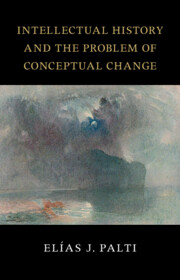Book contents
- Intellectual History and the Problem of Conceptual Change
- The Seeley Lectures
- Intellectual History and the Problem of Conceptual Change
- Copyright page
- Contents
- Preface
- Acknowledgments
- Introduction
- Chapter 1 Pocock, Skinner, and the “Historiographical Revolution”
- Chapter 2 The Republican Genealogy and the Normative Temptation
- Chapter 3 The Problem of Conceptual Change
- Chapter 4 Conceptual History
- Chapter 5 Koselleck’s Begriffsgeschichte
- Chapter 6 Hans Blumenberg and the Theory of Nonconceptuality
- Chapter 7 From Structuralism to Poststructuralism
- Chapter 8 Foucault’s Archaeology of Knowledge
- Chapter 9 The Archaeological Project and the Ignored Epistemic Mutation
- Chapter 10 Behind the Structures and the Subject
- Conclusion
- Epilogue
- Quoted Bibliography
- Index
Chapter 7 - From Structuralism to Poststructuralism
Pierre Rosanvallon and the “Conceptual History of the Political”
Published online by Cambridge University Press: 02 May 2024
- Intellectual History and the Problem of Conceptual Change
- The Seeley Lectures
- Intellectual History and the Problem of Conceptual Change
- Copyright page
- Contents
- Preface
- Acknowledgments
- Introduction
- Chapter 1 Pocock, Skinner, and the “Historiographical Revolution”
- Chapter 2 The Republican Genealogy and the Normative Temptation
- Chapter 3 The Problem of Conceptual Change
- Chapter 4 Conceptual History
- Chapter 5 Koselleck’s Begriffsgeschichte
- Chapter 6 Hans Blumenberg and the Theory of Nonconceptuality
- Chapter 7 From Structuralism to Poststructuralism
- Chapter 8 Foucault’s Archaeology of Knowledge
- Chapter 9 The Archaeological Project and the Ignored Epistemic Mutation
- Chapter 10 Behind the Structures and the Subject
- Conclusion
- Epilogue
- Quoted Bibliography
- Index
Summary
As Chapter 7 shows, the strong influence of structuralism in French intellectual history resulted into a different perspective of the “linguistic turn,” shifting the focus on a different dimension of language, besides the semantic and the pragmatic: the syntactic. This marks a sharper departure from the idea of political languages as “models of thinking.” Languages would refer to a second-order dimension of linguistic reality, and, as such, would be semantically indeterminated. They would give rise to many different forms of thought on the level of their ideological contents. Lastly, languages established the terrain for the mutual opposition among the different ideologies present in a given discursive context. As the chapter shows, it entailed a fundamental contribution to intellectual history. However, it rendered indeed more problematic the issue of conceptual change, which paved, in turn, the way to poststructuralism. A key figure here is Rosanvallon and his “conceptual history of the political.” He elaborates of the substratum of undecidability of political concepts, its aporetic nature, which makes of them properly political concepts. It thus entailed a further step in the process of desubstantializing of concepts initiated by the “new intellectual history.”
- Type
- Chapter
- Information
- Intellectual History and the Problem of Conceptual Change , pp. 145 - 166Publisher: Cambridge University PressPrint publication year: 2024



